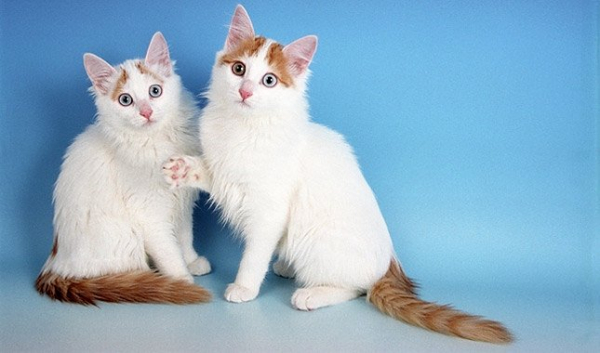Portréty oblíbených plemen doma i ve světě: Mops
Tito psi jsou mezi mini psími plemeny velmi populární. Neznám snad nikoho, kdo by nevěděl, jak mopsík vypadá. Věděli jste ale, že jde o starodávné plemeno z Dálného východu s velmi bohatou historií?
This beautiful and majestic cat gave name to a hair colour and it is the only domesticated breed that is not afraid of water and even can swim well. It has a strange and quite complicated nature and it is usually very dependent on humans.


Turkish Van is a natural breed, i.e. it developed on its own without human intervention. It happened, as its name suggests, in Turkey at the foot of Mount Ararat – specifically in an area around Lake Van which is almost isolated. The history doesn’t mention how cats got there. It is speculated that they could be the offsprings of semi-longhaired Chinese cats who came here on the Silk Road.
However, first Turkish cats were transferred to Europe in 1955 when two friends visited this area and were amazed by these wild semi-longhaired cats. No wonder, these creatures are really beautiful and intelligent and have a very unusual colour – two stains on their heads and a tail of the same colour. One of the two companions caught two cats and took them home with her, to England. It was a pair which was mostly white with characteristic red stains. Together with other, later imported cats from Lake Van, they established Turkish Vans breeding in Europe. The breed was already recognized in both England and Europe in 1971.
These cats have a quite strange character and if a person is not very experienced with cats, their behaviour may seem unpredictable. That’s why their breeding is not recommended to beginners. Turkish Vans are very focused on the human but if they think you don’t treat them kindly, they’ll let you know resolutely. A person who knows cats very well can read from their body posture what the animal is thinking. One needs experience for their breeding also because the peace and calmness are not their typical features.
Turkish Vans tend to get strongly attached to one person they devote all its love and inclination to. If there are other people living in the household, they will seek their company as well but they will keep their love manifestations only to the chosen one.
There are many good traits of this breed. These cats are active, like games and hunting. They also have a great deal of courage. They are not afraid of water like most other cats. On the other hand, there are some cats of this breed which even seek water and swim not only to get their prey but also for enjoyment.
Have you encountered this relatively rare and complicated breed yet? Even though its breeding is not as easy as pie, there are no doubts it’s worth it.


Tito psi jsou mezi mini psími plemeny velmi populární. Neznám snad nikoho, kdo by nevěděl, jak mopsík vypadá. Věděli jste ale, že jde o starodávné plemeno z Dálného východu s velmi bohatou historií?


Pokud pořizujete psa do domácnosti k dítěti, je potřeba nastavit jednoduchá, ale přísná pravidla pro obě strany. Vše musí fungovat, aby nedošlo k žádnému neštěstí. Jak si s tím poradit?


Označování psa mikročipem bude od 1. ledna 2020 povinností. Zajímá vás, jak to bude fungovat a co to pro vás bude znamenat?


Už na první pohled je jasné, že psi se od vlků v mnohém liší. Rozcházejí se v životním stylu i vzhledu. Jak to všechno ale začalo? Co může za to, že se z vlků začali stávat psi? Možná vás překvapí, že lidé nebyli tím prvním hybatelem.


Teploty pomalu ale jistě klesají a přichází čas vyndat kabáty ze skříní. Při oblékání bychom ale neměli zapomenout ani na naše čtyřnohé parťáky. Jak se zorientovat ve funkčním oblečením pro psy a jaké jsou rozdíly v materiálech?


I morčata se mezi sebou dorozumívají, a pokud se jejich řeč naučíme, lépe svému mazlíčkovi porozumíme a naplníme jeho potřeby.


Dny se krátí, i když se vám nyní daří vyjít se psem ven ještě za světla, venčení po tmě už se brzy stejně nevyhnete. Proto je dobré se připravit a psa dostatečně "označit". Budete tak mít stále přehled, kde se nachází a pro ostatní, hlavně řidiče,...


Na podzim kočky oblékají nový zimní kožich a starých chlupů se zbavují. V tomto období, stejně jako na jaře, kdy zas své kabáty shazují, je na místě zvýšená péče o jejich srst. Přílišným kartáčováním nebo používáním špatných nástrojů bychom ale kožich...


Aby odměna nezpůsobila pejskům víc škody než užitku, je třeba ji brát zodpovědně a s rozumem. Nezáleží na tom, jestli se jedná o pamlsek, pohlazení, pochvalu nebo hru.


Dny se krátí, rtuť v teploměru klesá, podzim je už definitivně tady. Jestli vaše kočka nežije výhradně jen v bytě, je nejvyšší čas začít ji na toto nehostinné roční období připravovat, aby její imunita nedostala zbytečně zabrat.


V dnešní době můžeme našim psím mazlíkům poskytnout i zvláštnější výdobytky než masáže. Zajít si mohou třeba na pedikúru či si zamlsat do psí cukrárny. U masáží ovšem nejde jen o rozmar. Pesanovi totiž dopomáhají k duševní i fyzické pohodě.


Napadlo by vás, že tenhle váleček na krátkých nohách býval honácký pes? Dnes už ale hraje převážně roli veselého a hravého společníka, který skvěle vychází s dětmi.